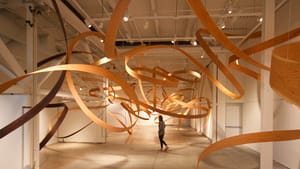Stay in the Loop
BSR publishes on a weekly schedule, with an email newsletter every Wednesday and Thursday morning. There’s no paywall, and subscribing is always free.
Illusory kinetic energy
Jeremy Holmes's 'Convergence' at Drexel University

Rhythmic gymnasts paint in air with the colors of ribbons attached to sticks. As they flick their wrists, spin their bodies, and make spirals, the ribbons dance, too, creating weightless shapes that endlessly morph. As we watch, we catch the graceful motion of the ribbons, but the forms are fleeting. What if they were suspended, frozen in time?
In 1,400 feet of five different kinds of North American hardwoods, Jeremy Holmes’s site-specific installation “Convergence” is what ribbons would look like if they could be unspooled in midair, free from gravity. I knew very little about “Convergence” before arriving at the gallery, so I was taken aback by the scale of the piece, surprised that it filled the room. “Convergence” drew me into its loops and curves.
“Convergence” engages the viewer with elements presented in unfamiliar ways: A solid, heavy material like wood seems pliable and floats in the air, and a simple gallery space is transformed into a hands-off playscape. Holmes attached maple, pine, white ash, cherry, and walnut boards to one another and bent them into coils, using the gallery space as his canvas. He describes his work as “three-dimensional line drawings in space,” and those wooden lines frame the negative space of the gallery, giving it its own form. Usually gallery spaces showcase art, but in this case, the piece itself displays the space. The sculpture casts shadows that give the walls dimension as it also contrasts its free-form contours to the sharp angles of the room. The piece juxtaposes the stark whiteness of the blank gallery walls and the warm golden tones of the wood-grain patterns while taking the viewer’s eye above the pipes, down into the corners, and up over partitions.
In this way, “Convergence” isn’t just an installation, but an interactive art piece. It invites the viewer to move around it, to duck under the arcs, step over the dips, and lean around the bends. The sculpture doesn’t accommodate our bodies — it’s up to the viewer to consider the sculpture and how to get close without touching it. The sculpture and gallery space seem to shift as the viewer travels to different spots, gaining unique perspectives in each place. This playful interaction gives the illusion of motion despite the stillness, as the sculpture seems to move relative to the viewer.
This illusory kinetic energy is the most obvious when the viewer attempts to follow the rollercoaster track of the piece around the gallery. Holding my finger in the air to trace to the form’s course, I went about the room, quickening my pace as the form seemed to rush by. After losing the path twice, my third attempt finally took me back to the place where the wooden ribbon began, attached to its end like a twisted Ouroboros, where the darkest wood is fused to the lightest. As a participant in this piece, the viewer must catch up and relate to it as a force to be reckoned with. The tension between movement and motionlessness evokes the notion of nonlinear time suspended in its continuation. Time cannot be understood apart from living it, and like the sculpture, it becomes our object of study but keeps us in its clutches.
“Convergence” pushes the limits of architecture, swimming through a space while also containing it. The viewer’s exploration of the curls and turns of the wooden sculpture is as much a part of the art experience as the art itself, suggesting that the “Convergence” here is not just at the seams of the wooden boards, but in the joining of viewer with the art. Where does one end and the other begin?
For a review of the Leah Stein Dance Company site-specific performance, Splice, click here.
What, When, Where
“Convergence,” Drexel University’s URBN Center Annex at the Leonard Pearlstein Gallery, 3401 Filbert Street, Philadelphia, through September 28. http://www.drexel.edu/westphal/resources/LeonardPearlsteinGallery/current/
The gallery is free and open to the public from 11am to 6pm, Wednesday through Sunday. There will be a closing reception and artist talk on Thursday, September 25 at 6pm.
“Splice,” a work by the Leah Stein Dance Company, will be performed September 18-21: http://www.leahsteindanceco.org/
Sign up for our newsletter
All of the week's new articles, all in one place. Sign up for the free weekly BSR newsletters, and don't miss a conversation.
